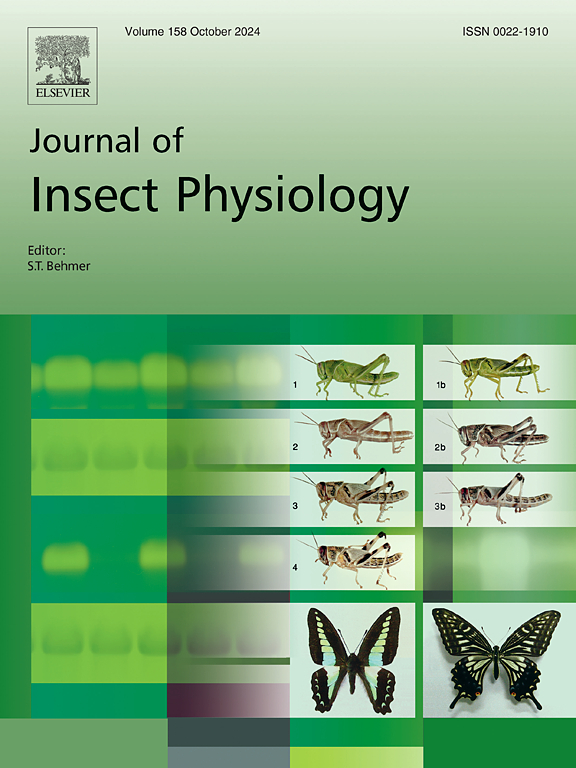化学感觉蛋白的敲除破坏了地下害虫幼虫的土壤引导行为。
IF 2.3
2区 农林科学
Q1 ENTOMOLOGY
引用次数: 0
摘要
近年来,RNA干扰(RNAi)已成为一种广泛研究的工具,用于基因功能分析和最近的害虫防治。elegans(鞘翅目:圣甲虫科)是智利特有的一种甲虫,在其幼虫阶段被认为是一种重要的害虫,作为白色幼虫,以有机物(OM)和作物根系(如小麦和红三叶草)为食。由于它的地下特性,控制受到限制。因此,研究化学感觉系统作为运输和识别环境中化学物质的基本组成部分,可以为认识和控制这种甲虫提供新的目标。近年来,秀丽隐杆线虫(H. elegans white grubs)的化学感觉基因得到了鉴定,并筛选出了一个化学感觉蛋白(chemosensory protein, CSP)。本研究旨在评估高表达的CSP在白蛴螬地下行为中的功能作用。为此,进行了食物偏好测定并进行了标准化。然后,基于选定的CSP合成双链RNA (dsRNA)。用dsRNA处理过的蛴螬进行选择性偏好试验。结果表明,相对于红三叶草根,蛴螬更喜欢OM高的泥炭。此外,随着OM含量的增加,CSP基因上调。最后,CSP的敲低导致土壤引导行为的破坏。该蛋白可能代表了秀丽隐杆线虫管理策略框架中需要研究的新靶点。本文章由计算机程序翻译,如有差异,请以英文原文为准。

Knockdown of a chemosensory protein disrupts soil-guided behavior of a subterranean larval pest
In recent years, RNA interference (RNAi) has become a widely studied tool for the functional analysis of genes and more recently, for pest control. Hylamorpha elegans (Coleoptera: Scarabaeidae) is a beetle endemic to Chile, considered an important pest during its larval stage as white grubs, feeding on organic matter (OM) and crop roots (e.g., wheat and red clover). Its control is limited due to its subterranean behavior. Thus, studying a chemosensory system as a fundamental part of the transport and recognition of chemicals from the environment could provide new targets for the knowledge and control of this beetle. Recently, chemosensory genes have been identified for H. elegans white grubs, and a chemosensory protein (CSP) was selected. This study aimed to evaluate the functional role of a highly expressed CSP in the subterranean behavior of white grubs. For this purpose, food preference assays were performed and standardized. Afterward, double-stranded RNA (dsRNA) was synthesized based on a selected CSP. A chosen preference assay was conducted using white grubs treated with dsRNA. Findings showed that white grubs prefer peat with high OM over red clover roots. Additionally, the CSP gene is upregulated when OM content increases. Finally, the knockdown of the CSP led to a disruption in soil-guided behavior. This protein may represent a novel target to be studied in the frame of management strategies for H. elegans.
求助全文
通过发布文献求助,成功后即可免费获取论文全文。
去求助
来源期刊

Journal of insect physiology
生物-昆虫学
CiteScore
4.50
自引率
4.50%
发文量
77
审稿时长
57 days
期刊介绍:
All aspects of insect physiology are published in this journal which will also accept papers on the physiology of other arthropods, if the referees consider the work to be of general interest. The coverage includes endocrinology (in relation to moulting, reproduction and metabolism), pheromones, neurobiology (cellular, integrative and developmental), physiological pharmacology, nutrition (food selection, digestion and absorption), homeostasis, excretion, reproduction and behaviour. Papers covering functional genomics and molecular approaches to physiological problems will also be included. Communications on structure and applied entomology can be published if the subject matter has an explicit bearing on the physiology of arthropods. Review articles and novel method papers are also welcomed.
 求助内容:
求助内容: 应助结果提醒方式:
应助结果提醒方式:


